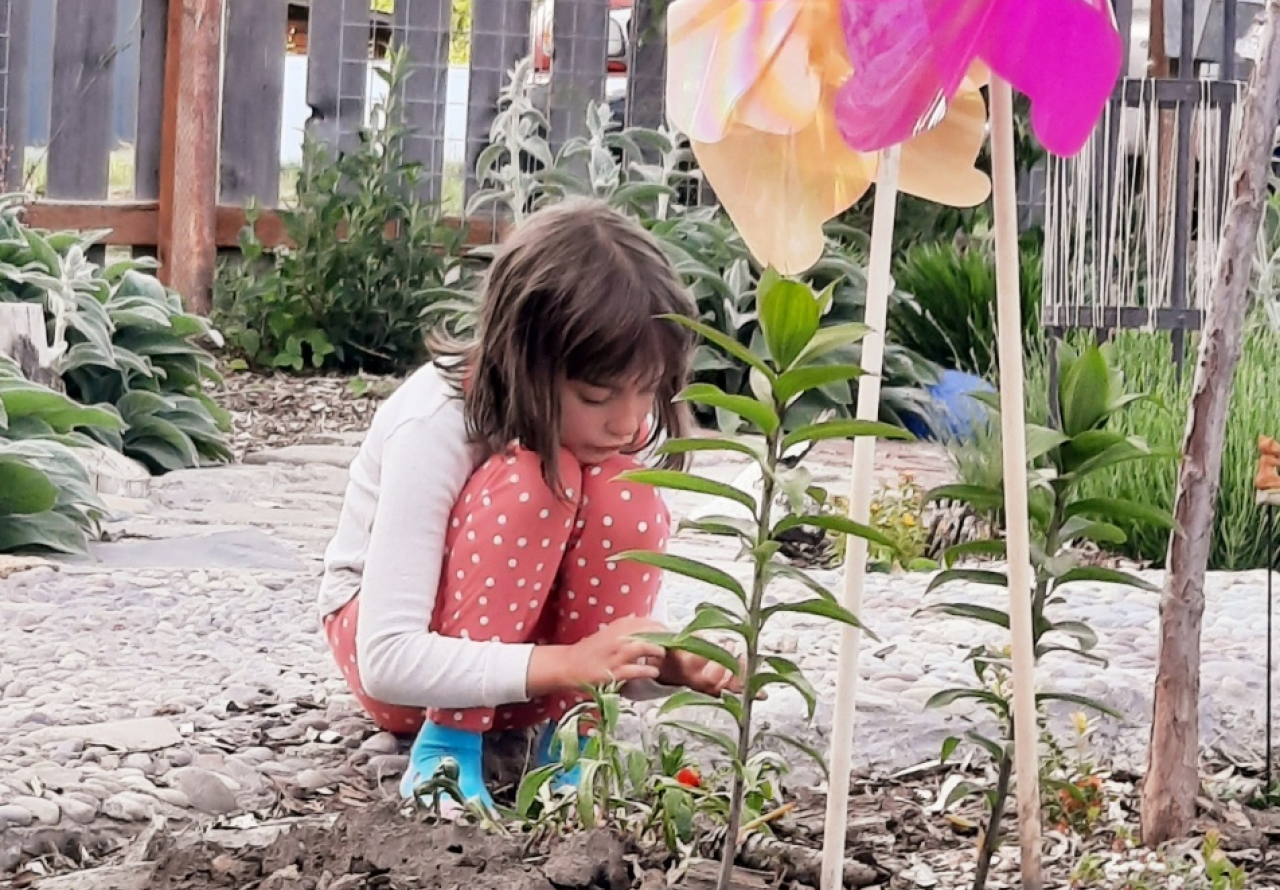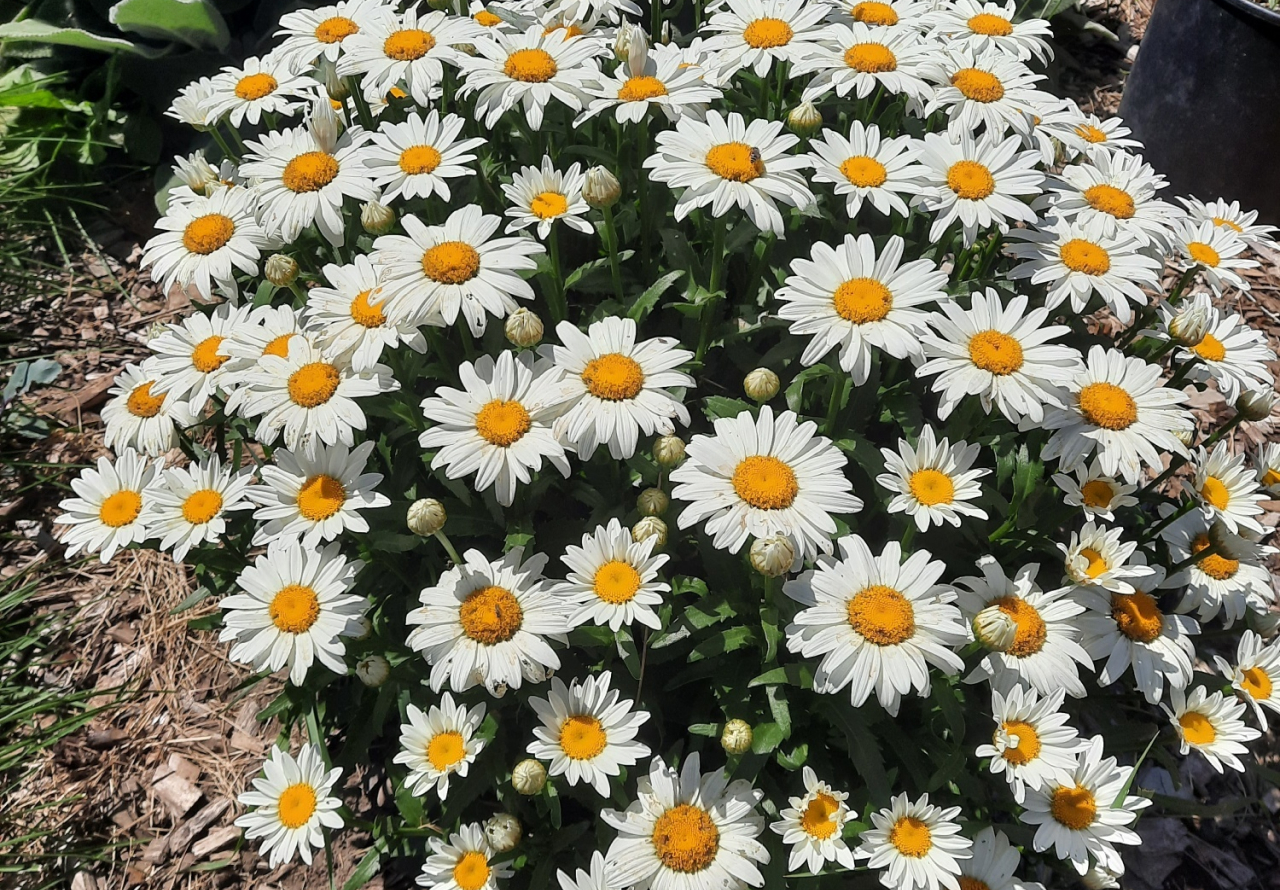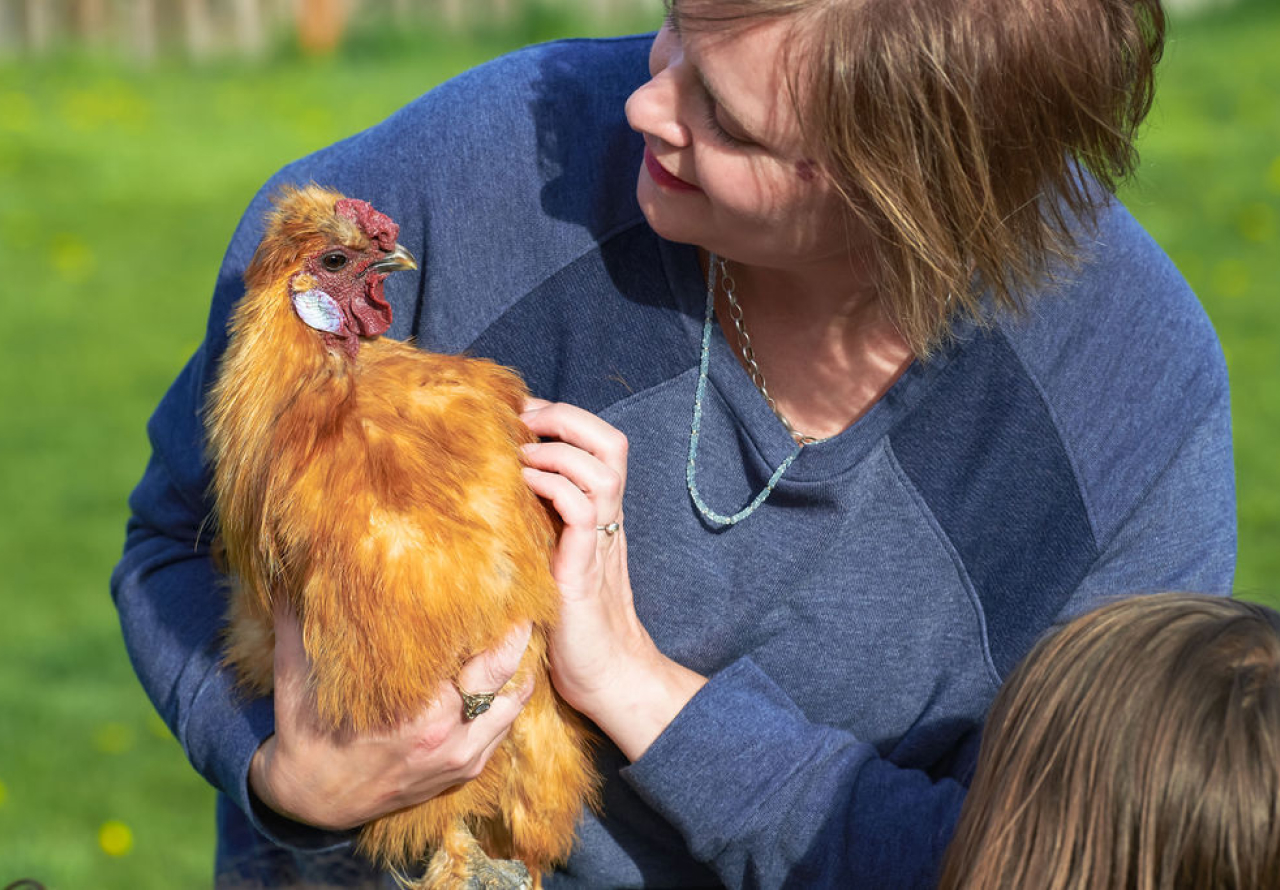Have you listened to Raising Wild Hearts podcast with Ryann Watkin??
It's one of my faves!
Goodpods ranks it "Top 10 Podcast for Homeschooling" and "Top 50 Podcast for Motherhood". Yes, get your hinder over there and check it out! You can start with my episode called "Nature, Sensory Learning, and Child Development".
Ryann and I had a fun, deep, and insightful convo about the critical importance of the child-nature connection, sensory-based nature play, and neurodiversity.
If you listened to just one of my podcasts, I'd say "THIS ONE!" Lots and lots of great nuggets.

I had the opportunity to sit down with Andrew Bartolotta, with CityCURRENT, about...you guessed it!...the power of sensory-rich nature play! Andrew and I went on a deep dive into how nature play stimulates not just five, but SEVEN sensory systems in children, and why it's vital for their holistic growth.
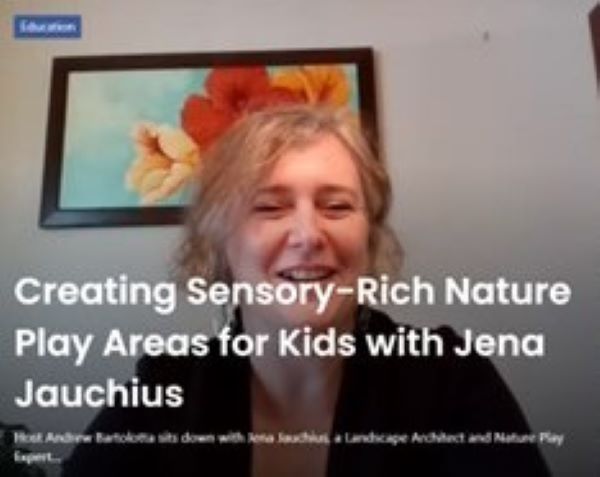
Andrew says "If you're seeking inspiration on how to transform your backyard into a sensory-rich playscape, or simply want to understand the profound power of nature in child development, this interview is a MUST-WATCH."
Proprioception is our body awareness sense!
Our proprioceptive (pro-pree-oh-cep-tive) system tells us where our bodies are relative to the things around us, and where our limbs are relative to our bodies.
Close your eyes and touch your nose with your pointer finger. This is your proprioceptive system at work!
Proprioception also has to do with the use of force necessary to do an activity, like coloring with a crayon with the right amount of force/pressure to not break it.
Just like the vestibular system, children’s proprioceptive system feeds on movement-based activities. A few play activities include:
CLIMBING up something and JUMPING off it, like boulders or a short set of logs, is great proprioceptive input. Many different muscles are being used and pressure is put on the upper and lower body joints. Balance and coordination skills are improved for better body confidence.
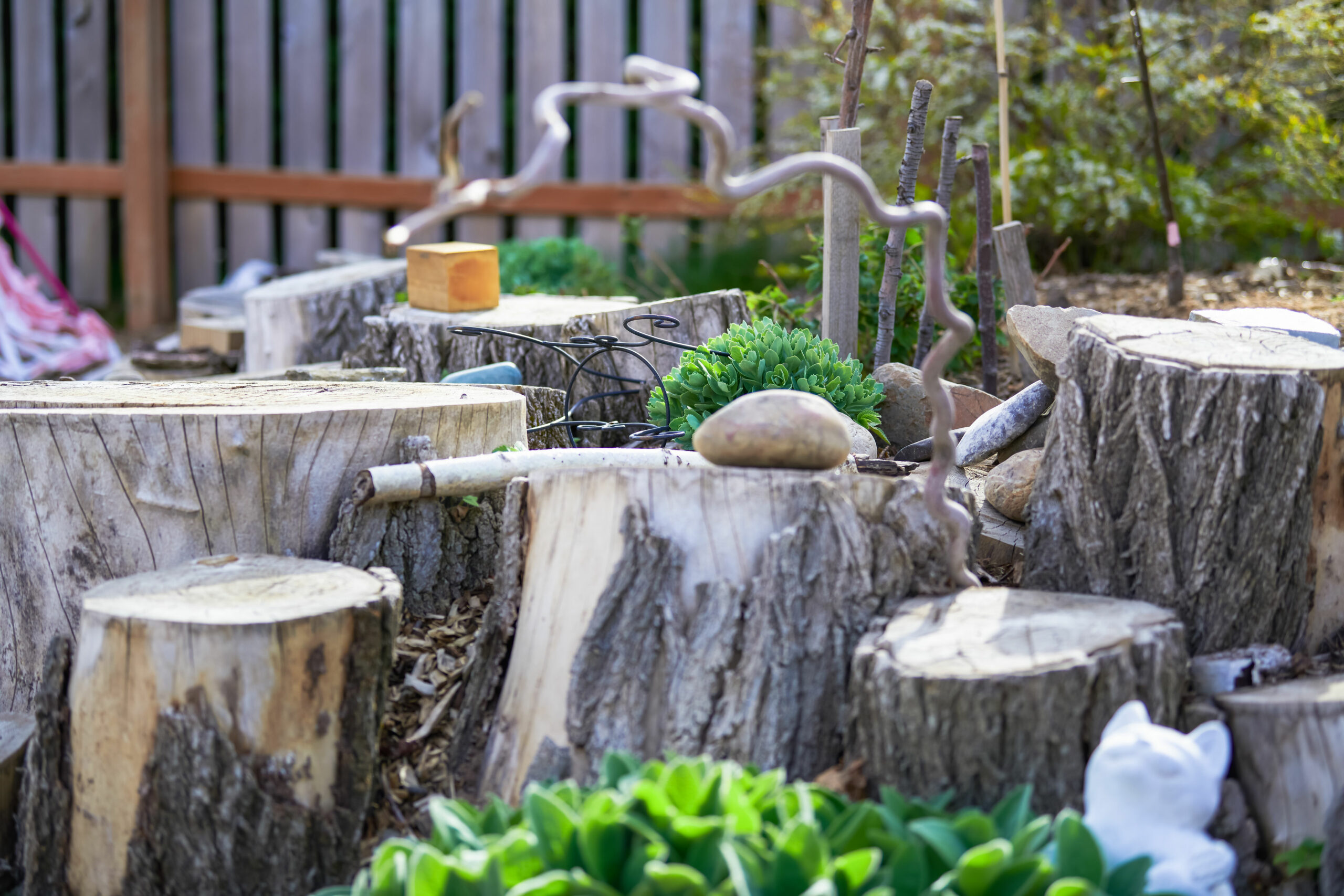
Big body movements like climbing and balancing feeds their proprioceptive system and increases body confidence.
Photo credit: Hara Allison Photography
GARDENING is filled with proprioceptive promise! Kids can use their bodies and tools in so many different ways while gardening. From planting seeds, to using a hand trowel, to raking, their bodies are getting good doses of stimulation.
When kids are PUSHING a child-sized wheelbarrow or PULLING a wagon are amazing play activities that involve balance, strength, and resistance.
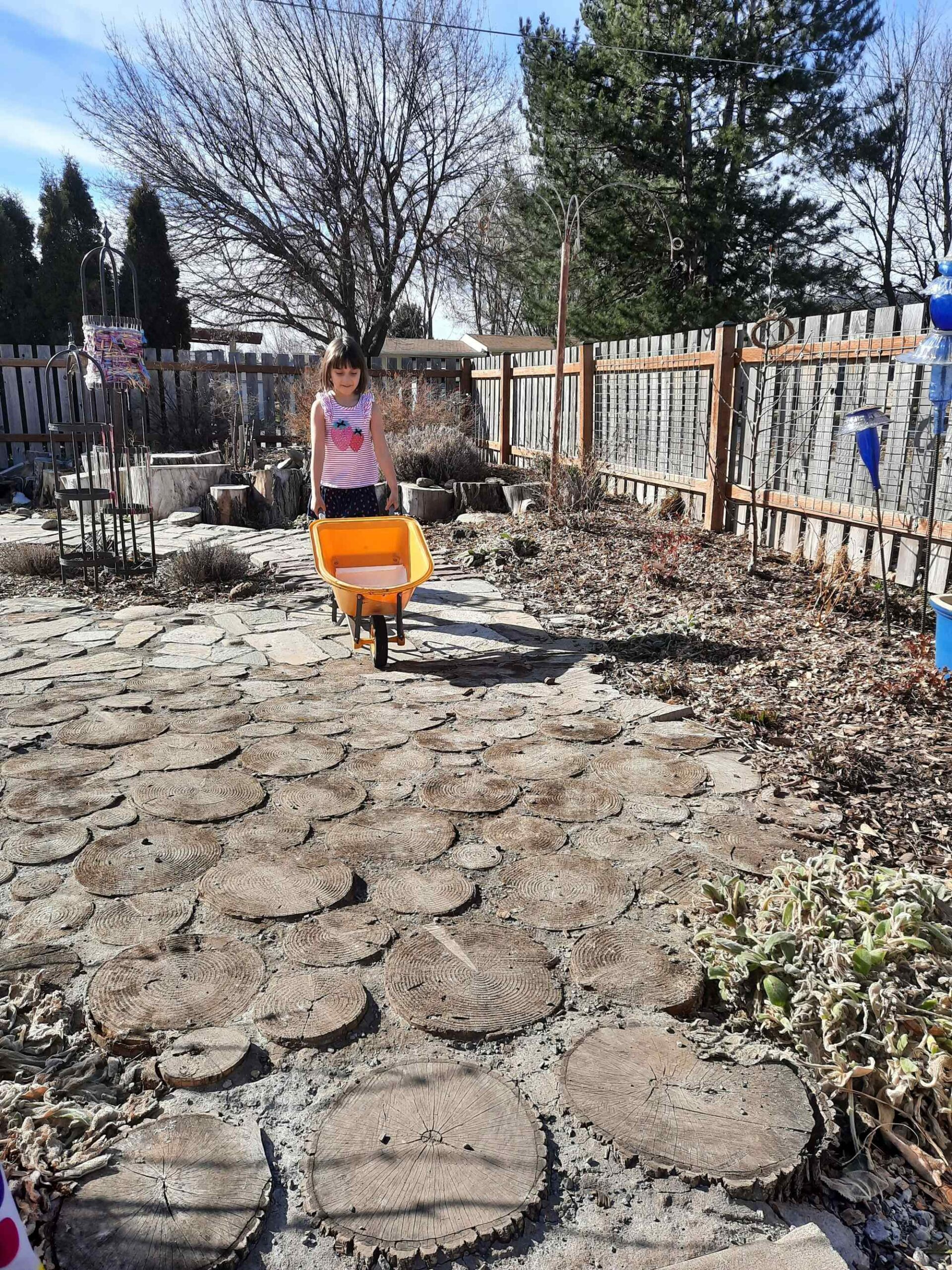
Pushing a wheelbarrow full of water across a sensory path gives this little body some high-intensity proprioceptive stimulation!
HUGGING is gives deep pressure and calms the nervous system.
Playing with LOOSE PARTS, like branches, stones, pinecones, seed pods, and other natural materials, involves movement, balance, fine motor skills, and other activities for proprioceptive input.
ONE OF THE KEYS OF SENSORY PLAY is that children must be given the opportunity to find the right intensity of sensory stimulation for their systems. Not all kids seek the same sensory experience or the same intensity of that experience.
Providing varying intensities of proprioception looks like this:
Pulling a wagon that is empty (less stimulation) compared to pulling a wagon that is full of play props or friends (more stimulation).
Using a watering can that is partially full (less stimulation) compared to using a watering can that is full (more stimulation).
How can your kiddo feed their proprioceptive system in their play space?
How can sensory plants promote body awareness in children? That’s a darn good question and a fun one to brainstorm a few answers:
First, plants are awesome for loose parts play! I always toot the Loose Parts horn loud and proud because it’s an incredible multi-sensory activity, including proprioceptive value.
Ornamental grasses with fun seed heads that can be picked and used for loose parts play. Or, Autumn Joy sedum, which has an incredible fall seed head which can be used during the cold months for winter-time play activities.
Many evergreen trees and shrubs provide cones of all shapes, sizes, textures, and colors which are fun to build with.
Second, edible sensory plants often provide proprioceptive input, as well.
For example, if you have several blueberry bushes planted in your kiddo’s play area, kids will walk around the bushes to search for ripe berries, possibly squatting, bending, and moving aside branches to find a cache. They’ll also use their fingers to pick the ripe berries (pressure/force/coordination), and put them in their mouths (eye-hand coordination)
Gardening is one of my favorite activities for proprioception stimulation. Everything from planting seeds, to watering, to transplanting seedlings, to pruning, to picking and eating their harvest gives beneficial proprioceptive stimulation. Add in some different garden tools for extra value!
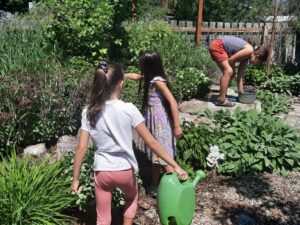
Proprioception in the garden looks like this. Hefting a watering can, climbing and balancing on logs, walking on uneven surfaces, and more!
Check out my eBook, Nature Play for the 7 Senses: A Parent’s Guide for Natural PLay & Learning Spaces for ALL Children
In his amazing book “The Universal Sense: How Hearing Shapes the Mind”, author and neuroscientist Seth Horowitz says our auditory sense is 20x – 100x faster than any of our other senses.
That means everything else we experience is influenced by what we hear.
Additionally, sound is very much tied to our emotions. What does all this have to do with nature play??
Well, for kids, this means their play and learning experiences are informed first by the sounds they hear, whether or not they see the source of the sound. The emotions the sound evokes give them an indication of good or not so good, exciting or dull, safe or unsafe, and so on.
Sounds that are soothing, joyful, interesting, and otherwise positive help regulate our nervous system and bring us into sensory balance where we can play, learn, interact, create, and do all the marvelous things that happy humans do.
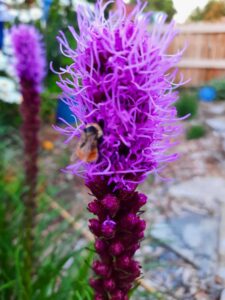
The buzzing of a honeybee can signal many feelings, including excitement or nervousness.
Sounds that are loud, jolting, irritating, raucous, and otherwise uncomfortable will send our nervous systems into 'flight or fight’. When our system is imbalanced, we are in survival mode and are only able to what’s absolutely essential to get through the situation.
For example, a child playing in a playground hears mom’s voice nearby which gives them the feeling that it’s ‘safe’ to play here. Even though mom isn’t in their field of vision, the child knows she’s there for them. Mom’s voice may evoke in them the feelings of calm, joy, love, and well-being. Feeling safe and happy, this kiddo can have positive play experiences, social interaction, and higher creativity.
For outdoor sensory play, I like to think of sound in 3 main types: nature sounds, social sounds, and musical sounds.
Nature sounds are birdsong, the breeze rustling the leaves of an aspen tree, toes wriggling in gritty sand, and water splashing. Studies show that nature sounds help calm our nervous system.
Social sounds, as you can guess, revolve around our personal interactions, like playing, talking, whispering, singing, laughing, crying, and shouting. Sometimes social sounds are positive, nurturing experiences, and sometimes they’re not.
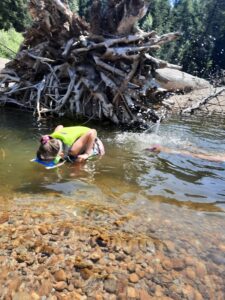
Splashing in the water at our favorite river spot.
And, of course, music is rich food for children’s developing bodies and brains.
Music has a lot going on: rhythm, harmony, vibration, singing, emotion. For children, listening to a song (which, for kids, also means moving and dancing) is a powerful sensory integration experience, and it also builds neural pathways in the brain, enhancing their cognitive ability.
Within each of these three types is vibration, or the feeling of sound. Each sound has a different sound wave, which we can feel through our skin/tactile sensory system. The vibrational feeling of a bass drum thumping compared to the vibration of a xylophone is very different, whether you’re putting your hands directly on the instruments or letting the sound waves hit your skin.
With sound also comes the need for quiet. A cozy space is an essential feature of any play area. I’ve talked about cozy spaces in earlier posts, but these are child-sized structures that give a child some personal space, often to self-regulate. A forts, a tipi, a nook carved out in the vegetation are examples.
What if you and your kiddo closed your eyes outside in their play area. What do you each hear? Does what you hear change with the seasons? How so? These are all great conversation to have with your little one. Encourage them to expand their vocabulary here.
How can you think of your child’s play space as a soundscape?
Children are always experimenting with sound. The natural world is a rich soundscape, where plant life takes center stage.
When you provide plants for sound experiences, you open up a new dimension of environmental learning for your kiddos to learn about the world around them and their interactions with it.
Seed pods rattle when shaken.
Tree leaves rustle in the breeze.
Ornamental grasses make inviting scratchy, swishy, swooshy sounds when kids brush by or the wind whistles through.
Here are a few plants that contribute to the symphony of a sound garden:
All Gold Japanese Forest Grass (Hakonechloa macra ‘All Gold’), hardiness zones 4-9
There are many options for kid-friendly ornamental grasses, but Japanese Forest Grass is one of my favorites. The primary reason being their leaf blades are smooth to the touch and very inviting. Whether kids brush it with their leg as they walk by or run their hands through it like their tousling someone’s hair, this happy little grass responds in pleasant swooshes. The All Gold variety has gorgeous golden yellow color to add some visual appeal and multi-sensory value.
18” tall and wide
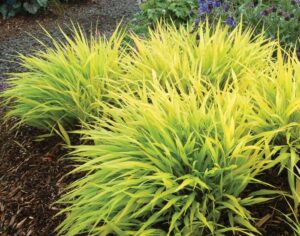
All Gold Japanese Forest loves to be rustled by little hands.
Silver Dollar Plant (Lunaria biennis), hardiness zones 5-9
This plant gets its name from the seedpod that form after it blooms in the spring. The roundish, flat pods start out green and turn an iridescent white over time the plant dries out. Each dried stalk has a mass of dried silver dollars on it and give a papery rattle sound when shaken. Considered a hardy annual in the northwest climate, they can spread enthusiastically by seed.
Approx. 30” tall x 18” wide
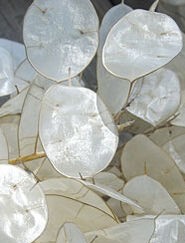
The seed pods of the Silver Dollar Plant have a raspy-papery-rattly sound.
Karl Foerster Feather Grass (Calamagrostis acutiflora ‘Karl Foerster’), hardiness zones 5-11
Feather reed grass is a favorite, and for good reason. These grasses can take a beating, I mean ‘loving’, from kiddos at play and shake it off like nuthin’ happened. I’ve planted this grass in a maze-like pattern in several playscapes. As kids wind their way through these grasses give off a happy rustling sound. Leave the seed heads on over the winter for four-season play opportunities.
4’-6’ tall and 2’-3’ wide
Quaking aspen, (Populus tremuloides), hardiness zones 2-6
Quaking aspen are magical trees. In cooler climates, they naturally grow in a variety of conditions. In the fall, their leaves turn a brilliant yellow like a ray of sunshine in the forest. This tree is named for the sound its leaves make in the wind. They quake, they tremble, they clack together and make the wind visible. Aspen spread by underground rhizomes, so if you have one aspen, you’re about to have more. If you have the room for this tree in your landscape, wonderful! If not, keep an eye (and an ear!) out for aspen groves when you go on family hikes.
50’ tall x 25’ wide
Again, be sure that all plants in the play area are non-toxic. And, always and forever, pesticides, herbicides, and other harmful chemicals should NEVER be used in play areas.
Check out my eBook, Nature Play for the 7 Senses: A Parent’s Guide for Natural PLay & Learning Spaces for ALL Children
Aaaaaaaaaaaahhhhhhhhhhhhhhh! Smells like NATURE PLAY!
Let’s explore our fascinating olfactory system and all those wonderful scents, fragrances, aromas, and odors that emanate from outdoor play and learning.
Our sense of smell transcends time and space. This sense is connected with our memory, and one whiff of a particular scent transports us back in time to when that memory was created.
For me, the subtle, fleeting scent of peonies reminds me of instantly my grandfather, Julius, and my time spent at his rural farmhouse. When he wasn’t doing dairy farming, he was growing the most amazing, colorful flower gardens, which included masses of peonies. As a youngster, I used to bury my face in them and inhale deeply, comparing the fragrances of the different colors.
The sense of smell closely connects us with nature, literally. As I just mentioned, when we smell a flower, we put it up close to our face. We breathe it in. We inahle all the amazing smell molecules and they become part of us. The scent, beauty, and energy of the flower is gifted to us through our breath. We roll the leaves of the plant, crushing it, to make the smell even stronger. Through this interaction, our experience elevates.
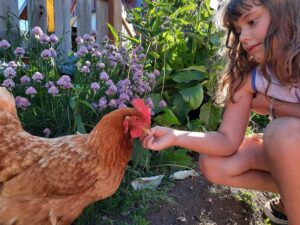
Nothings says “aroma” like farm animals! Caring for creatures is a multi-sensory experience and a way for kids to learn compassion and caring for others.
Adding different aromas to a play area can be done through fragrant plantings, water and sand play areas, areas where kids can dig in the soil, and compost areas (yes, kids like funky smells, too).
Signage can be helpful to communicate the use of the space, especially for kiddoes with autism and other neurodiversities who may deduce the sensory potential. Consider adding a little sign that says “Smell Me” so kids understand the purpose and are encouraged to explore their senses in this way.
To boost social skills and communication, ask them to describe what it is they’re smelling. Ask it how it makes them feel. Encourage them to expand their vocabulary beyond “good” or “bad”. Ask them how one plant’s smell compares with another’s. Have a conversation about it. You never know what you might learn.
So, with the olfactory system in mind: How many ways does your kiddos’ play space delight their sniffer? What else can you add to make it a fuller bouquet of aromas? Go experiment!
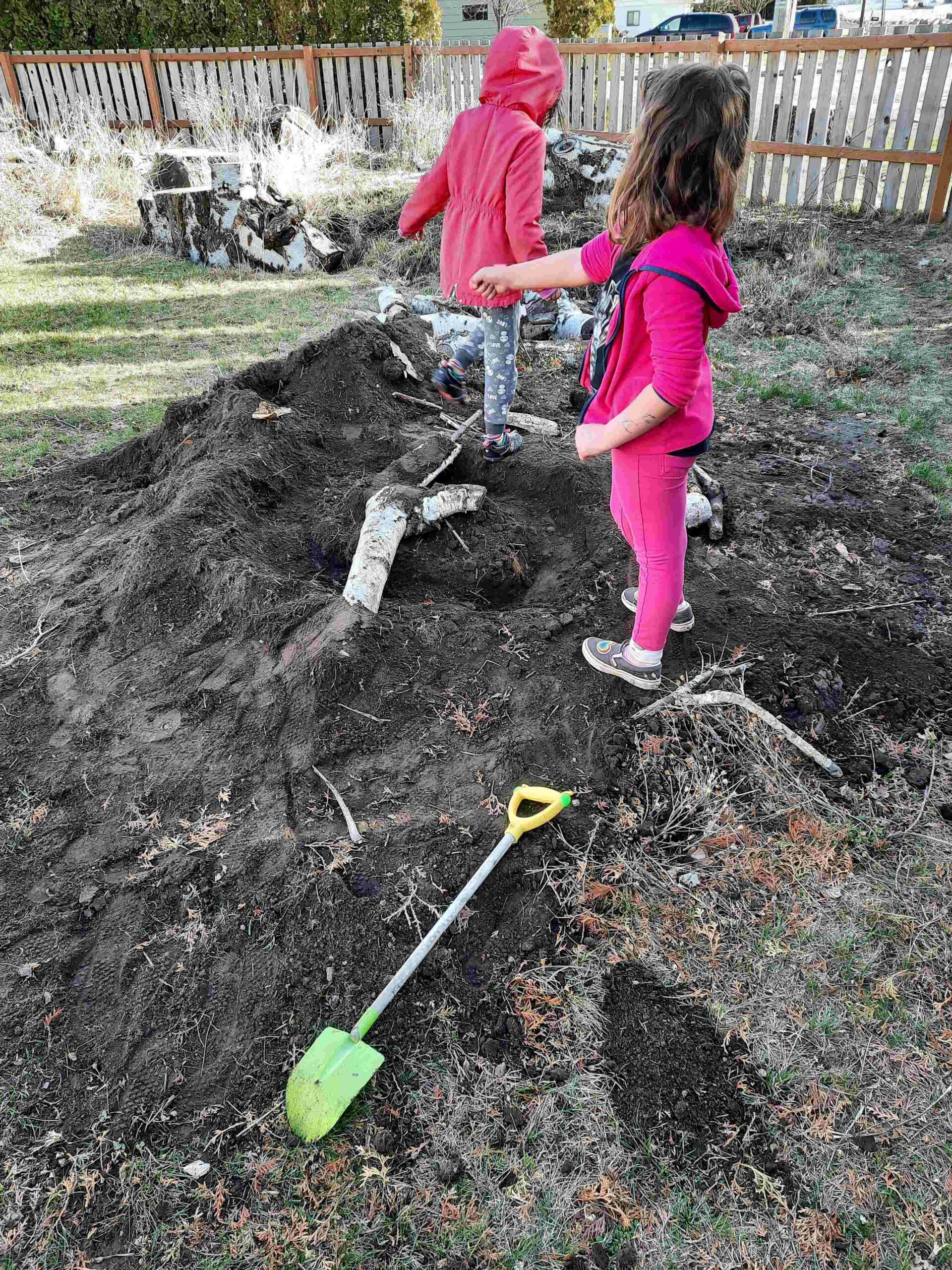
Digging is in the earth is one of the best multi-sensory activities kids can do. We are innately drawn to the smell of earth.
My girls had one of their little friends over for a play date. We were all out goofing around in our little sensory garden.
This little gal was zipping around, every once in a while stopping to smell this flower and that.
She flitted over to a chocolate cosmos plant and gently touched her nose to one of the decadent brown daisy-like blossoms.
I will never forget the look of sheer delight and surprise on her face!
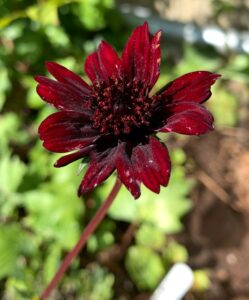
The magnificent, chocolate-smelling Chocolate Cosmos. No playscape should be without.
“This smells like a Hershey bar!!!” She gathered up my girls to share in the novelty of her unexpected, profound discovery.
The list of plants with amazing aromas is a very, very long one. Here are a few of my favorites that will turn your kids into hound dogs as they track down their favorite scents:
Chocolate cosmos (Cosmos atrosanguineus), hardiness zones 9-11
This incredible flower, as I already mentioned, has an extraordinary fragrance. Smelling of sweet chocolate it’s sure to be a favorite! An annual in my climate, I treasure this plant for the time I have it, and then replant again the following spring.
24” tall x 18” wide
Scented geraniums, hardiness zones 10-11
Mostly grown as annuals, scented geraniums come in dozens of different fragrances: apple, mint, chocolate mint, orange, lemon, citronella, rose, apricot, lime, peppermint, cinnamon, cedar, and more. I grow mine in containers and bring them inside when temps drop. I. LOVE. THESE. PLANTS.
Grosso lavender (Lavandula ‘Grosso’), hardiness zones 6-10
Lavender is known for its aroma-therapeutic properties and is one of the most popular fragrances in the world. This French lavender variety is used in fancy perfume concoctions because of its exceptional fragrance. The flower spikes are longer and more graceful than English lavender.
24” – 36” tall and wide
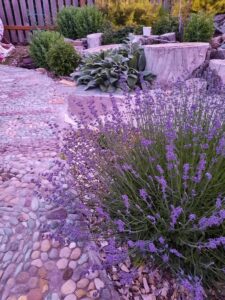
Lavender is a fabulous plant for children’s spaces because of it’s multi-sensory qualities, including its renowned fragrance.
Lilacs, hardiness zones 2-7, depending on the variety
These hardy shrubs perfume the spring air with their heady, sweet scent. It’s a crying shame that their bloom time is so stinkin’ short-lived. Not all lilacs are equally fragrant. For the most potent experience, I recommend ‘Miss Kim’ (lavender blue bloom, 6’ tall and wide), ‘Sensation’ (purple and white bloom, 10’ tall x 6’ wide), and ‘Maidens Blush (pink blooms, 8’ tall and wide).
Reine des Violettes Climbing Rose, hardiness zones 5-11
This nearly thornless rose is perfect for play spaces. Plant them to ramble along a fence or blanket a pergola. This rose produces highly fragrant, violet-colored flowers all summer long.
Climber to 10’ tall
Vanilla Spice Summersweet (Clethra alnifolia ‘Vanilla Spice), hardiness zones 4-9
The sweet-spicy fragrance of this summersweet will attract both children and pollinators! This low maintenance plant features whimsical white bottlebrush-shaped blooms all summer long.
3’-5’ tall and wide
Check out my eBook, Nature Play for the 7 Senses: A Parent’s Guide for Natural PLay & Learning Spaces for ALL Children
Visualize brown, papery pinecones; spring daffodils nodding their yellow heads in the breeze; grey, armored roly poly bugs; delicate ethereal spider webs sparking with morning dew; and bright red maple leaves that flutter to the ground in the fall.
Can you picture cheerful wind spinners making a breeze visible; homemade, hand painted birdhouses; colorful flowers in your grandmother’s garden, and a cheeky little gnome statue peeking out from behind a moss-covered log…what do all these things have in common?
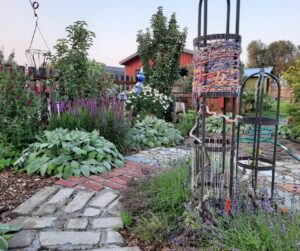
This garden offers high visual stimulation through variety of color, texture, form, pattern and other features.
They’re a feast for the eyes!
Sight is the way many of us interpret our world.
Through sight, we come to understand the place in which we live. We develop an interpretation and understanding of its characteristics, its visual properties.
We see and connect with our loved ones and with ourselves.
Children’s vision rapidly developed from birth until the age of 3. In that time, they become aware of, identify, and interpret things like shapes, colors, distance, and depth.
Children also build their vocabulary and social skills by naming and describing what they see. At the same time, they’re connecting with others AND with the natural world.
Nature itself offers seemingly infinite variety for us to observe and interact with through our sight. The patterns and colors of butterfly wings. Puffy, round dandelion seedheads. Light refracting off a pool of water. Dark spores on the underside of a fern leaf. Rainbows.
It would take me more than a lifetime to list all of nature’s incredible sights.
The more nature in a play space, the more variety of high-quality visual stimulation is present. Log rounds, chunky bark pieces, boulders, seed pods, flowers, grass stalks, water, sand, plants, and trees…again, the list is very, very long.
In a playscape, we can complement the natural world by incorporating different man-made shapes, forms, patterns, textures, and colors. We can provide additional visual elements to further capture children’s attention, inspire their imagination, and beg for interaction.
Some ideas for adding visually stimulating sensory features include a sculptural garden arbor with climbing vines, kinetic features like wind spinners, garden art and sculpture, colorful plantings, outdoor murals, and tools like a magnifying glass or magnifying station, kaleidoscope, or telescope.
How you create visual interest and experience is only limited by your imagination.
Nature offers the best kind of sensory stimulation! When plants are added to a children’s play area, the space literally comes alive.
Sensory plants are those that have particular qualities that engage our senses in different ways.
We’re talking about the sense of sight this week. Plants have different sizes, shapes, colors, and visual textures. Depending on how you use them, they can excite or soothe.
Rousing warm colors (red, orange, yellow) ‘advance’ visually, whereas calming cool colors (greens, blues, purples) tend to recede visually.
Massing plants, or planting them in greater quantities, gives a visual punch and draws the eye.
Plants with interesting forms are columnar, weeping, and twisted. You might use these plants as focal points or landmarks in the playscape.
Some plants and trees have interesting bark texture that invites a child’s touch. Add these where children can easily access them, like near a cozy space or along a path.
And, flowers, ooooooh the flowers. They come in infinite expressions of beauty. Kids love picking bouquets of blooms just to feel connected with nature’s dazzling drama.
Here’s a small sampling of plants that delight children’s sense of sight:
Paperbark maple, Acer griseum, hardiness zones 5-8
I have one of these small trees in our sensory garden. It’s greatest sensory trait is its flaking, curling cinnamon colored bark.
Approx. 25’ tall x 15’-20’ wide
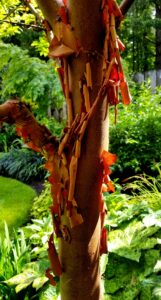
Paperbark Maple Photo credit: the beautiful Vickie Devlaeminck
Harry Lauder’s Walking Stick, Corylus avellana ‘Contorta’, hardiness zones 3-9
With its gnarled, twisted branches, this small tree looks like it came straight out of a Tim Burton film!
8’ – 10’ tall and wide
Magical Gold Forsythia, Forsythia x intermedia ‘Kolgold’, hardiness zones 5-8
As winter makes way to spring, forsythia’s blooms are like radiant sunshine. This early bloomer brings cheer to any early garden. The flowers are also edible and can be used salads or made into jelly, syrup, and tea!
4’ – 5’ tall and wide
Dark Horse Weigela, Weigela florida ‘Dark Horse’, hardiness zones 4-8
This weigela (pronounced vie-gela) has dark purple-bronze foliage, which makes a beautiful statement itself, and is especially dramatic when paired with chartreuse- or blue-colored foliage plants. It has a long bloom season with its trumpet-shaped magenta flowers.
3’ tall and wide
Fanfare Blanketflower, Gaillardia x grandiflora ‘Fanfare’, hardiness zones 3 – 10
This is a plant that will excite your little ones with its incredible yellow, orange and red blooms. This blanketflower has unique petals, so plant it where children can inspect it, in a fairy garden, along a pathway, or nearby a sitting area.
12” high x 18” wide
Gladiator Allium, Allium ‘Gladiator’, hardiness zones 4 – 10
There are many choices of allium, but the one that makes the biggest statement is Gladiator. This bulb sends up a globe shaped flower that is like an exclamation point in the garden! Plant in clusters of 5 or more to make a real statement.
36” - 60” tall
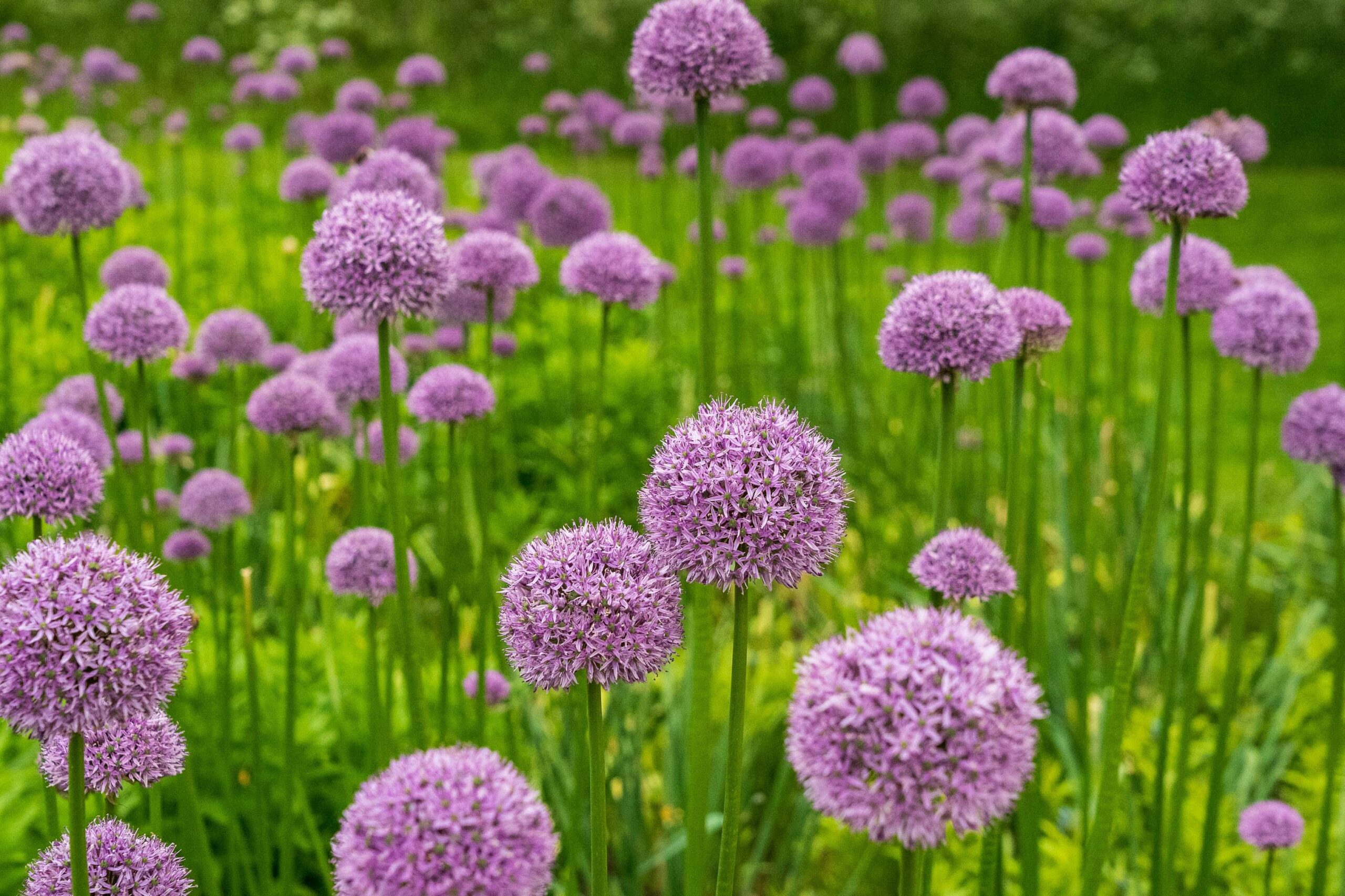
Allium Credit: Nick Fewings, Unsplash.
Purple Passionflower, Passiflora incarnata, hardiness zones 6 – 11
What can I say, there aren’t many blooms that rival the detail and uniqueness of a passionflower. This climbing vine is perfect for arbors, tunnels, and cozy spaces. Plant this where children have a chance to sit quietly and inspect this floral masterpiece.
12’ – 25’ long
Sunflower, Helianthus species, hardiness zones 4 - 9
To me, sunflowers are the “children” of the plant world. They’re full of life, innocence, sunshine, and cheer. My favorite uses of sunflowers are ‘sunflower houses’. Plant sunflower seeds in a circle, approximately 5’ – 6’ diameter. As they grow, they can be guided to arch together to form a vegetative hut (cozy space).
Heights vary
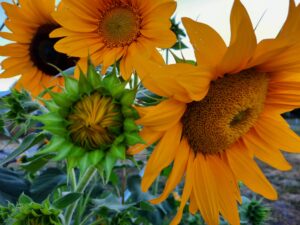
Sunflower
As always, be sure that all plants in the play area are non-toxic (there are a lot of online resources available to confirm a plant’s nontoxicity).
Also, pesticides, herbicides, and other harmful chemicals should NEVER be used in play areas. Children, especially those experiencing neurodiversities, are more vulnerable to the harmful effects of environmental toxins than adults.
Now that you have some ideas for enhancing the visual interest of your kids’ play and learning space it’s time to take action. Pick one thing that you know your kids would love. Better yet, have them pick one thing! Make it a fun family project and you’ll all benefit.
Wishing you the very best in creating a beautiful play and learning space for your kiddo!
Check out my eBook, Nature Play for the 7 Senses: A Parent’s Guide for Natural Play & Learning Spaces for ALL Children
Our sensory systems are the filters through which we understand our world. As children, it is the ‘language’ we use to speak with our environment.
Something interesting happens when a child enters an environment, whether it's a park playground, an outdoor classroom, a streetscape, or even their own bedroom.
A child initiates an unspoken conversation with their environment, and it goes something like this...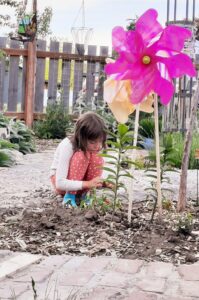
A child asks <hey, environment> “what can you offer me?” “What can I experience here?” “How can I play and spark my imagination?” “How will I know I’m safe?” “What can I learn from you?” “How may I grow here?”
And, the internal questioning continues...
The environment responds to the child, always. It responds to them in a language they can easily understand: through their senses. The natural environment is rich in color, shape, texture, fragrance, sensation, taste, movement, and on and on. The conversation begins as the child starts playing, and the dialogue becomes more rich and deep as they explore, discover, and develop a relationship with the space.
This loving, nurturing silent conversation happens between nature and children of any ages, even infants. This beautiful dialogue takes place between nature and children who are non-verbal. Nature is always speaking to us. We have to still ourselves to listen.
And, we must allow our children time and place to still themselves as often as possible because, for them, these conversations quickly develop into a relationship with nature that lasts their entire lives. A relationship that anchors them, especially when their lives can get turbulent.
This is one of the many reasons I advocate for nature play.
Nature play is one of the best tools we have to give our children what they need to develop into the amazing humans they're meant to be.
American novelist Henry Miller once said, “The moment one gives close attention to any thing, even a blade of grass, it becomes a mysterious, awesome, indescribably magnificent world in itself.”
Moments like this make me appreciate Miller’s sentiment.
One early summer day not too long ago, my girls and I were out in the sensory garden picking raspberries (we were going to make freezer jam). One daughter, who has a beautiful, well-tended gift for distraction, noticed that there were more ladybugs than usual out. Commenting that there are a handful of ladybugs on the Autumn Joy sedum plants nearby, she went in for closer inspection.
My other daughter and I decided that what she was doing was a heck of a lot more fun that what we were doing so we joined in on the discoveries. We found several different kinds of flies hanging out on the unopened flower buds. We discovered a spider who had created her egg nest on the cupped underside of a leaf. Then, we found the most magical thing of all!
We noticed dried slug slime trails running up the stem and leaves and going all the way up and across the fanned out flower heads! It looked like "magical rainbow tape", as one of them described it.
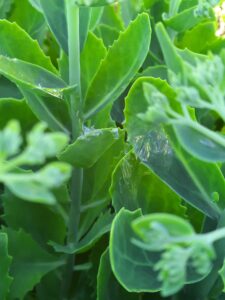
Look closely and you’ll see the magical rainbow tape!
The dried slug trail was paper thin and fragile. We gently poked it and it broke. It was clear with an iridescent, rainbow sheen. I despise finding slugs in the garden, but that morning they left us something that sparked my 7-year old twins’ imaginations.
Their favorite hypothesis about the magical rainbow tape was that it was a gift from the slugs to the ladybugs. Ladybugs are small and it takes a long time for them to get from one sedum stem to another. They’d have to travel all the way down, over to the next stem, and then all the way up. Exhausting!
The slugs, apparently kind and generous by nature, wanted to leave the ladybugs bridges between the stems to make their travels more convenient. They have really tiny legs, after all.
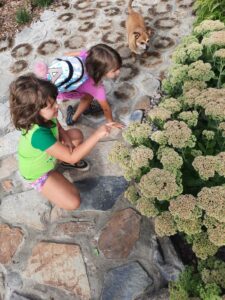
Children’s connection with nature is indescribably beautiful and essential!
Here, in one unassuming sedum plant, we found the multiple, indescribably magnificent worlds, each with their own rich story.
Here, I witnessed the beating heart of nature connecting with the open hearts of my children. There is magic all around us, all the time. Often, it takes our children to point out the obvious for us. Thank goodness they do.
Sensory plant feature: Autumn Joy Sedum, Sedum spectabile ‘Autumn Joy’, hardiness zones 4 – 11, grows to approx. 24” tall and slightly wider. Truly a 4-season perennial!
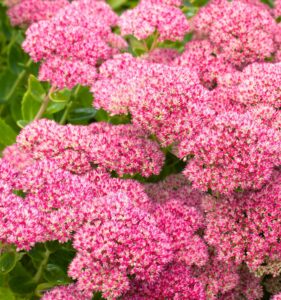
Autumn Joy sedum in bloom!
Check out my eBook, Nature Play for the 7 Senses: A Parent’s Guide for Natural PLay & Learning Spaces for ALL Children
